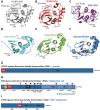Viral OTU deubiquitinases: a structural and functional comparison
- PMID: 24676359
- PMCID: PMC3968130
- DOI: 10.1371/journal.ppat.1003894
Viral OTU deubiquitinases: a structural and functional comparison
Abstract
Recent studies have revealed that proteases encoded by three very diverse RNA virus groups share structural similarity with enzymes of the Ovarian Tumor (OTU) superfamily of deubiquitinases (DUBs). The publication of the latest of these reports in quick succession prevented proper recognition and discussion of the shared features of these viral enzymes. Here we provide a brief structural and functional comparison of these virus-encoded OTU DUBs. Interestingly, although their shared structural features and substrate specificity tentatively place them within the same protease superfamily, they also show interesting differences that trigger speculation as to their origins.
Conflict of interest statement
The authors have declared that no competing interests exist.
Figures


References
-
- Komander D, Rape M (2012) The ubiquitin code. Annu Rev Biochem 81: 203–229. - PubMed
-
- Clague MJ, Urbe S (2010) Ubiquitin: same molecule, different degradation pathways. Cell 143: 682–685. - PubMed
-
- Huang TT, D'Andrea AD (2006) Regulation of DNA repair by ubiquitylation. Nat Rev Mol Cell Biol 7: 323–334. - PubMed
Publication types
MeSH terms
Substances
LinkOut - more resources
Full Text Sources
Other Literature Sources

